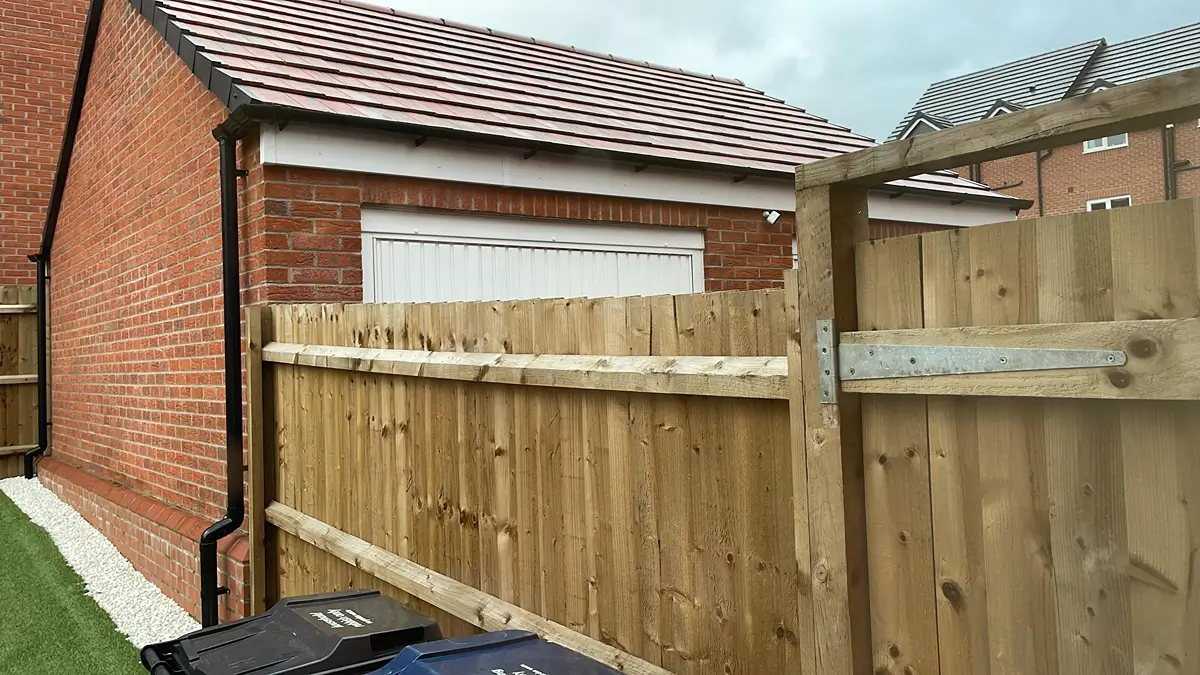Thinking of putting up a new fence around your garden? Or maybe you’re wondering whether your neighbour’s panels are pushing the limit? Fence height might seem like a small detail, but in the UK, it’s a legal matter—and getting it wrong can lead to fines, planning trouble, or neighbour disputes.
This guide answers all the real questions homeowners ask: how tall can your garden fence legally be? Does the front garden have different rules? Can you add trellis on top? We’ll break it all down clearly so you know where you stand—whether you’re building for privacy, kerb appeal, or security.
Disclaimer: This guide provides general information on UK planning laws. Always check with your local council’s planning department for rules specific to your area and property.
Understanding Fence Height Laws in the UK
When it comes to fences, UK law sets clear limits on height—especially when it borders a public road or pavement (Gov.uk).
Legal Height for a Garden Fence
In most UK homes, the maximum height for a garden fence is:
- 2 metres (about 6ft 6in) at the back of your property
- 1 metre (around 3ft 3in) at the front if it faces a highway (this includes pavements and footpaths)
That means you can install a 6ft fence in your rear garden without needing planning permission, but the moment it’s in the front garden or visible from the road, the height must be lower—just 1 metre unless you get approval (Planning Portal).
Even if you’re adding a trellis or screen for privacy, the total height—including the top feature—must still stay within the 2-metre limit in the back and 1 metre in the front. If you go above that, you’ll need to submit a planning application to your local council. Failure to comply may lead to enforcement notices—or fines up to £2,500 (and up to £20,000 for repeat offences) under the Town & Country Planning (General Permitted Development) Order 2015 (Ideal Home).
Difference Between Front and Rear Garden Fences
A front garden is any part of your property that faces or touches a road, not just the area near your front door. So if you’re thinking of building a driveway fence, a low decorative front fence, or installing panels on a boundary wall, the 1-metre rule applies.
This includes:
- Driveway front garden fences
- Low fences beside footpaths
- Front lawn fences facing the street
Even if your fence is decorative or low-maintenance—like those sold at B&M, Wickes, or garden centres—the same height rules apply. So a 4ft (1.2m) panel in the front garden? That would need planning permission.
Maximum Heights Allowed: Practical Examples
Let’s look at some real-world scenarios that UK homeowners face when deciding how tall a fence can be—and where the rules apply.
Rear Garden Fencing
In most back gardens, you’re allowed to install fences up to 2 metres high without needing planning permission. That includes:
- Standard 6ft fence panels (about 1.83 metres)
- A small trellis on top, as long as the total stays under 2m
- 7ft fence panels or tall screening? You’ll need permission for those
If you’re adding a decorative top, like a lattice panel or privacy trellis, the total height must still fall within the limit. Homeowners often assume trellis doesn’t count—but it does. Anything solid or semi-solid that’s fixed to the fence adds to the full height.
Want extra privacy but stay within the law? Go for dense hedging, plant climbers along a 6ft panel, or choose screening ideas that grow taller without breaching planning limits.
Homeowners often assume trellis doesn’t count—but it does. Anything solid or semi-solid that’s fixed to the fence adds to the full height (Duffield Timber).
Front Garden Fencing
Front fences have stricter limits: if they face a road or footpath, they must not exceed 1 metre in height—unless you have planning approval.
Here’s what falls under this rule:
- Fences along a driveway that lead to a public road
- Low boundary fences along pavements
- Front garden fences near estate roads or cul-de-sacs
So if you’re eyeing 4ft fence panels (1.2m) or planning a decorative white picket fence from your local store, it’ll need to be shortened—or approved. This law helps maintain roadside visibility and preserve the street scene.
Fence Between Neighbours
When building a fence between two properties, especially in semi-detached or terrace homes, the height limit is still 2 metres, but neighbour communication is key.
If the fence straddles a shared boundary, it’s best to:
- Agree on the height and style together
- Get any changes in writing
- Avoid sudden changes, like switching from a 4ft panel to a 7ft wall
Disputes often happen when one homeowner adds height without discussion—especially for privacy. Councils can get involved if a fence breaches planning limits, and some homeowners have been fined or ordered to remove non-compliant fencing (The Sun).
Fence Panel Sizes and Styles
When choosing a fence, size matters—not just for looks but also to stay within the legal height limits. Let’s break down what’s commonly available and how it fits within UK regulations.
Common Fence Heights
Most UK fence panels come in standard sizes:
- 4ft panels (1.2m): Often used for front gardens and decorative boundaries
- 5ft panels (1.5m): A good compromise for privacy without overwhelming space
- 6ft panels (1.83m): The go-to for rear gardens—offers privacy while staying within the 2m rule with a gravel board or post cap
- 7ft panels (2.13m): These go beyond the legal limit and need planning permission if used alone
If you’re adding extras—like trellis, lattice tops, or fence toppers—you’ll need to factor that into the total height. Even something as simple as post caps or decorative arches can push the fence just over the legal threshold.
Popular Panel Styles and Suppliers
Plenty of UK homeowners turn to well-known DIY and garden centres for fencing solutions. Among the most popular are:
- B&M fence panels: Affordable and widely available, these include 4ft and 6ft options in timber or composite
- Hazel fence panels: Rustic and eco-friendly, perfect for cottage-style gardens or natural screening
- Heavy duty fence panels: Ideal for long-term durability and wind resistance
- White garden fence options: Often decorative and suited to front garden designs, especially in coastal areas
- Fence panel wedges and toppers: These help balance sloped gardens while keeping height legal
Whether you’re shopping for a short fence to frame your front garden or a tall panel for backyard privacy, always check the combined height once posts, gravel boards, and toppers are in place.
Fencing Ideas for Privacy and Design
Not every fence is about keeping things in (or out). For many UK homeowners, fencing is also about making a style statement, creating privacy, or defining space—especially in smaller front gardens where every inch matters.
Privacy-Focused Garden Fencing
If privacy is your top priority, there are plenty of smart, legal ways to achieve it without crossing the 2-metre rule in the back garden:
- Use 6ft fence panels and add climbing plants like clematis or jasmine for natural coverage
- Add trellis panels on top of a standard fence—just ensure the total height doesn’t exceed 2 metres (Duffield Timber)
- Consider decorative screens, bamboo rolls, or woven hazel panels for a softer look
- Plant tall shrubs or hedges close to the fence line—but beware of encroaching on your neighbour’s space
If your garden is overlooked, a combination of panel and planting can offer privacy without triggering planning issues.
Front Garden Fence Ideas
Front gardens in the UK often come with space constraints and stricter rules, but you can still create visual interest and structure without going over the 1-metre limit (Gov.uk).
Try:
- White picket fencing for a traditional look
- Panelled fencing with gaps or slatted designs for airflow and style
- Hazel hurdles or low woven panels for rustic charm
- Low composite fences for a sleek, modern boundary
- Decorative 4ft fence panels trimmed down to legal height with stylish post caps
Many homeowners combine fencing with raised flower beds or brick bases—but again, height rules still apply from ground level to the top of the structure.
Creative Touches That Comply with Law
If you want something beyond plain panels, these options help keep your fence compliant while looking good:
- Fence toppers with curves or scrollwork
- Fence on wall design (but measure from ground level to top)
- Adding a short trellis to grow ivy or roses
- Painting fence panels in muted or heritage colours to blend with the property
Want to go taller? Planning permission is the safe route—but often, smart design gets you the look you want without the paperwork.
Planning Permission: When and How
So, what if you want a fence taller than the standard limits? Whether it’s for privacy, security, or design, you’ll need to go through your local authority—and knowing the process upfront can save a lot of hassle.
Can I Build a Taller Fence Legally?
Yes—but only with planning permission if:
- Your rear garden fence exceeds 2 metres
- Your front garden fence is over 1 metre and borders a public road
- You’re adding height to an existing boundary wall or fence that’s already near the legal limit
In these cases, your local planning department will want to know:
- The proposed height (including trellis, toppers, or screens)
- Where on the property it’s being placed
- The materials and style you’re using
- Whether it will affect visibility for drivers or pedestrians
If your fence is too tall and you haven’t applied? The council can serve an enforcement notice. In some cases, homeowners have been fined or forced to take down fences that were only slightly over the legal height.
How to Apply for Planning Permission
Here’s how to do it right:
- Contact your local planning authority (LPA)—you can find them via your local council’s website
- Prepare a basic drawing or diagram showing fence placement and height
- Submit the application and pay a small fee (typically around £200)
- Wait for approval, which may take 6–8 weeks
Speaking with your neighbours first can smooth the process—objections could influence your application outcome (Living Etc). Their objections can influence whether the council approves or rejects your plans.
Fence Height Exceptions and Special Cases
There are some extra rules if your property is:
- In a conservation area
- A listed building
- Near a highway with visibility concerns
- On sloped or uneven ground where height measurements get tricky
Also, if your fence sits on top of a retaining wall or raised bed, the total height from ground level still counts toward the legal limit.
Want to be safe? Stick to the standard sizes or ask your council before you build.
Fence Costs in the UK
Before you start digging post holes or placing orders for panels, it’s a good idea to know what your fence might actually cost. From timber panels to composite systems, prices can vary depending on height, materials, and whether you’re going DIY or hiring a professional.
How Much Does a Garden Fence Cost?
Here’s a quick breakdown of average costs per panel in the UK (as of 2025):
- 4ft wooden fence panel: £25–£35
- 6ft heavy duty panel: £35–£60
- 7ft privacy panel (with trellis): £60–£80+ (permission may be needed)
- Hazel or willow screening: £20–£50 depending on quality
- Composite fence panels: £60–£120 each
Prices vary depending on where you shop—B&M, Wickes, Travis Perkins, and online suppliers all offer different ranges. B&M often stocks budget-friendly 4ft and 6ft panels, perfect for quick upgrades on a tight budget.
You’ll also need to budget for:
- Fence posts: £10–£30 each (wood, concrete, or metal)
- Post caps and finials: £3–£10 each
- Gravel boards: £10–£20 per section
- Fixings and brackets: around £20–£40 for a full run
- Fence paint or treatment: £15–£40 per tub
Additional Costs to Consider
If you’re hiring a professional installer, labour typically costs £60–£150 per day, with full installations averaging £1,000–£2,000 depending on the length and terrain.
Also, keep in mind:
- Waste removal fees if you’re replacing an old fence
- Extra charges for access difficulties or digging into hard soil
- Planning permission costs (if applicable): around £200
If you’re planning to install tall panels like 7ft fence sections or add custom top lattice, these extras can quickly push up your final cost—so measure carefully and keep everything under legal height where possible.
Summary: Making Smart Fence Choices
Building or updating a garden fence in the UK isn’t just about picking a style you like—it’s about staying within legal limits, maintaining good neighbour relations, and getting the most value for your money.
Here’s what to keep in mind:
- Rear garden fences can be up to 2 metres tall without planning permission
- Front garden fences, or anything facing a road or footpath, are limited to 1 metre (LawHive)
- Trellis, toppers, or screens all count toward total fence height
- Anything above these limits requires planning permission—and skipping that step could lead to enforcement or fines
- Talk to neighbours before building along shared boundaries—it’s not just polite, it can help prevent legal disputes (Living Etc)
- Costs vary by height, material, and installation method, so plan your budget accordingly
A good fence does more than mark your property—it can improve kerb appeal, increase privacy, and add a sense of security. Whether you’re installing low panels in the front garden or adding screening to the back, knowing the rules helps you build smart, stay compliant, and avoid surprises later.





